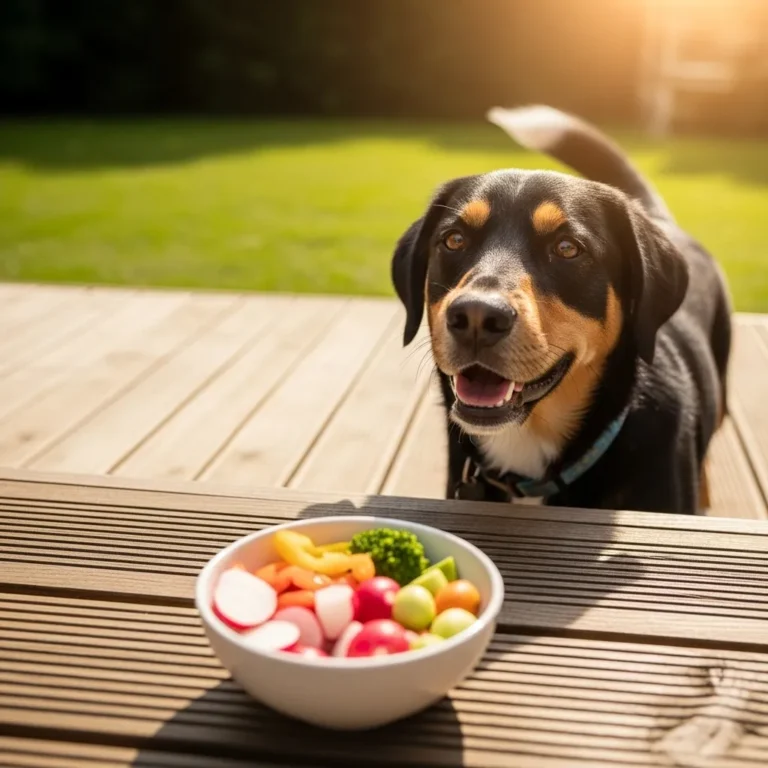
Can Dogs Eat Radishes? A Crunchy Conundrum for Paw-rents!
Hey there, fellow dog lovers! It’s your favorite furry-foodie friend, back with another deep dive into those “can-my-dog-eat-this?” moments we all have. Picture this: you’re chopping up a vibrant salad, and those crisp, peppery radishes are looking mighty fine. Suddenly, you feel a wet nose nudge your leg. You look down into those soulful, begging eyes, and the question pops into your head: “can dog eat radish?”
I’ve been there more times than I can count! As a proud pup parent myself, I know we all want to share our healthy snacks with our four-legged family members. But navigating the do’s and don’ts can feel trickier than teaching a puppy to roll over! So, let’s grab a comfy spot on the couch and chat all things radishes and dogs. We’ll sniff out the safety facts, uncover any nutritional perks, and talk about the best way to serve these little red globes if your pooch is curious. Get ready for some tail-wagging info!
Notice: You will find the sources at the end of the article.
General Safety & Nutritional Value
Alright, let’s get right to the meaty part of the bone—are radishes a friend or foe to Fido? The answer is usually a relieving one!
Are radishes safe for dogs to eat?
In a nutshell? A cautious yes! Radishes are generally considered safe for most dogs to eat in moderation. Phew! They’re not on the scary “no-fly” list with chocolate or grapes. But—and it’s a big but—”safe” doesn’t always mean “amazing for every dog.” Think of it like us trying a new exotic fruit; some of us love it, and others might end up with a funny tummy.
I always like to see what the experts say, and the Chief Veterinary Officer for the AKC, Dr. Jerry Klein, often reminds us that while many human foods are A-OK, the golden rules are moderation and proper prep. Anything new should be a slow and steady introduction.
Are radishes good for dogs?
“Good” is a strong word, but they aren’t bad! Radishes aren’t a canine superfood, but they have their merits. They’re super low in calories, which is a massive win for our chunky, funky friends who might be on a diet. And let’s be real, who isn’t trying to keep their pup at a healthy weight?
I like to think of them as a fun, crunchy, and hydrating treat rather than a dietary staple. For some dogs, that satisfying crunch is just as exciting as a new squeaky toy!
Do radishes offer any nutritional benefits for dogs?
They won’t work miracles, but they do bring a little something to the picnic! They’re packed with water, which is great for hydration on a hot day. Beyond that, they’ve got a decent fiber content, which is always a good thing for keeping things moving, if you catch my drift.
What nutrients do radishes contain?
Let’s peek at the nutrient label on this crunchy snack:
- Fiber: This is the star of the show! Fiber is fantastic for digestive health and keeping your pup’s system regular. Just remember, too much of a good thing can lead to, well, gassy consequences.
- Vitamin C: Yep, radishes have it! This antioxidant is great for immune support. While our pups make their own, a little extra from whole foods can be a nice boost, especially for senior dogs.
- Potassium: This handy electrolyte helps with muscle function and keeping those fluids in balance.
- Other Trace Minerals: There are tiny amounts of other goodies in there, but not enough to make radishes a primary source.
The key takeaway? Our dogs get everything they need from their high-quality kibble. Treats like radishes are just the cherry on top—or the crunch in the bowl! As the fantastic holistic vet Dr. Karen Becker often shares, whole foods can be wonderful supplements, but they should always play a supporting role to a complete and balanced diet.
Potential Risks & Concerns
Okay, so the green light is on, but we still need to pump the brakes a little. Let’s talk about the potential ruff patches.
Are there any dangers in feeding radishes to dogs?
For most dogs, a tiny bit of radish is no big deal. But we have to be mindful of a few things, mainly their tricky digestion and that signature radish “zing.”
That peppery kick? It comes from compounds called isothiocyanates. In small amounts, they’re generally fine, but they can be a bit irritating to a dog’s sensitive tummy, especially if your pup goes to town on a whole bunch. Imagine eating a handful of spicy peppers—you’d feel it later!
Can radishes cause digestive problems in dogs?
Oh, you bet they can. This is Public Enemy Number One when it comes to radishes and dogs. That high fiber content I mentioned? It can backfire spectacularly. Too much fiber can lead to:
- Gas: Oh, the horror! The silent-but-deadly kind that can clear a room. Radishes can definitely turn your pup into a little gas factory.
- Diarrhea: An overload of fiber can speed things along a bit too efficiently, resulting in some messy situations.
- General Tummy Ache: The strong flavor and compounds can just be too much for some dogs, leading to nausea or even vomiting.
The rule of thumb? Introduce any new food at a snail’s pace and watch your dog like a hawk. If you see any signs of a upset tummy, cut the radishes out and make sure they have plenty of water. If things don’t settle, a call to the vet is always the best move.
What are the potential side effects of dogs eating radishes?
Beyond the digestive drama, here’s what else to watch for:
- Choking Hazard: A whole, round radish is a perfect choking risk, especially for small dogs or those who inhale their food without chewing.
- Dental Discomfort: They’re hard! For a pup with dental issues or sensitive teeth, that crunch might be more ouch than yum.
- Pesticides: If you’re not using organic, there could be icky residues. A good scrub-a-dub-dub is non-negotiable!
Can dogs be allergic to radishes?
It’s not common, but just like people, dogs can be allergic to anything. Keep an eye out for:
- Itchy skin, especially on the paws, face, or ears
- Redness or hives
- Vomiting or diarrhea
- Swelling around the face
If you spot any of these, it’s time to ring up your vet, stat!
Are there any parts of the radish plant that are toxic to dogs?
Great question! We usually munch on the root, but what about the leafy tops? We’ll get to the greens in a sec, but the good news is the radish plant itself isn’t known to be toxic like some other garden veggies. The main issue is still that potential for digestive irritation from the strong flavor.
Feeding Guidelines & Preparation
So, you’ve weighed the pros and cons and you’re ready to let your pup try a radish. Awesome! Here’s my step-by-step guide to doing it the right way.
How should I prepare radishes for my dog?
A little prep goes a long way in keeping your pup safe and happy.
- Wash, Wash, Wash! Get rid of all the dirt, grime, and any potential chemicals. Even organic ones need a good bath!
- Peel ‘Em (Optional but Smart): The skin can be extra fibrous and bitter. Peeling can make it gentler on your dog’s stomach and tastier, too.
- Chop into Tiny Bits: This is the most important step! For small dogs, think pea-sized. For big dogs, you can go a little bigger, but always err on the side of caution. You can even grate a tiny bit over their food for a fun texture.
- Keep it Plain, Please! No salt, no pepper, no butter, no nothing! Our seasonings are a no-go for their tummies.
What is the appropriate serving size of radishes for dogs?
Remember, we’re going for a treat, not a meal!
- Start with a Nibble: For the first time, offer just one or two tiny pieces. Watch your dog closely for the next day to see how they handle it.
- Small Dogs: A few pea-sized pieces (about a quarter of a small radish) is plenty.
- Medium Dogs: Maybe half a small radish, chopped up.
- Large Dogs: A whole small radish, chopped, might be okay, but don’t go overboard.
A good rule of paw is that treats should make up no more than 10% of your dog’s daily calories. Radishes are so low-cal that the real limit is their tummy tolerance!
How often can I give my dog radishes?
Because of their potential for causing tummy troubles, radishes are a “once in a blue moon” treat. If your dog handles them well, maybe once or twice a week in a tiny quantity is fine. They are definitely not an everyday snack. If your dog has a sensitive stomach, it’s probably best to just skip them.
Can puppies eat radishes?
I’d give a firm paws off for puppies. Their little digestive systems are so sensitive and are still developing. They need very specific nutrients for growth, and radishes just don’t offer enough benefit to risk an upset tummy. Stick to puppy-formulated food and treats for your little one.
Can older dogs or dogs with health conditions eat radishes?
For seniors, the same rules apply—moderation is key! But if your old pal has dental issues, that hard crunch might be uncomfortable. Grating it finely could be a solution.
Now, listen up, this is important: If your dog has any health issues—especially digestive problems like IBS, kidney disease, or diabetes—you must chat with your vet before offering radishes. Your vet knows your dog’s unique health story and can give you the best advice. For a diabetic dog, for example, even low-sugar foods need to be carefully considered.
Are there any types of radishes dogs should avoid?
The common red radish is the usual suspect, but there are others:
- can dogs eat daikon radish: These big white radishes are often milder, which might make them a better option. Still, wash, peel, and chop!
- Black Radishes: These guys are super pungent and strong. I’d avoid them altogether for your pup—too much potential for irritation.
- Wild Radishes: Steer clear! You never know what they’ve been exposed to. Stick to the radishes from your grocery store or farmer’s market.
Alternatives & Related Foods
Maybe radishes aren’t your dog’s jam, or you’re just looking to mix up the veggie treat roster. No worries! There are so many other fantastic, dog-safe options.
What are some dog-safe alternatives to radishes?
If you’re looking for that satisfying crunch, you’ve got options! My top picks include:
- Carrots: The ultimate doggo veggie! Crunchy, great for teeth, and packed with beta-carotene. My pup goes bonkers for a baby carrot.
- Green Beans: Low-cal, crunchy, and a hit with so many dogs. Raw or steamed, they’re a winner.
- Cucumbers: Super hydrating and crunchy with very few calories. Just maybe scoop out the seedy middle for sensitive pups.
- Celery: A good crunch, but make sure to chop it small to avoid those stringy bits.
- Broccoli & Cauliflower: In tiny, cooked amounts, these are fine, but beware—they can be gassy!
- Bell Peppers (Red, Yellow, Orange): So sweet and full of Vitamin C! Skip the green ones as they’re harder to digest.
- Zucchini: Mild, squishy when cooked, and usually very easy on the stomach.
Remember, always introduce new foods slowly! When in doubt, your vet is your best resource. I always love checking out the Tufts University Petfoodology blog: https://vetnutrition.tufts.edu/ for science-backed advice from veterinary nutritionists like Dr. Cailin Heinze, who reminds us that a balanced dog food comes first, and treats are just for fun.
Can dogs eat radish leaves/greens?
Ooh, good question! We eat the greens, so can they?
While not toxic, radish greens can be even more irritating to a dog’s digestive system than the root. They’re fibrous and contain concentrated versions of those compounds that can cause tummy troubles.
My advice? Skip the greens. It’s just not worth the risk of an upset stomach when there are so many other safe and delicious greens out there (like a tiny bit of cooked spinach). Let’s keep those tails wagging happily!
The Verdict: A Crunchy “Maybe” for Your Canine Companion
So, after all that sniffing around, what’s the final word on can dogs eat radish?
It’s a solid “maybe, with conditions.” They’re not a bad food, but they’re not a must-have either. For some dogs, they’re a fun, novel crunch. For others, they’re a one-way ticket to Gassyville.
If you do decide to share, remember the paw-lease: wash, peel, chop tiny, and start with a minuscule amount. Watch your best friend closely. And never, ever forget that your veterinarian is the ultimate source of wisdom for your unique pup.
At the end of the day, there are loads of other veggies that are easier and safer for our furry family members. But if your dog gives them a curious sniff and a happy crunch, a little bit now and then is perfectly fine. Now, who’s ready for a walk?
please leave comment
you may like it





sources
- https://www.akc.org/expert-advice/nutrition/can-dogs-eat-radishes/
- https://www.petmd.com/dog/nutrition/can-dogs-eat-radishes
- https://www.masterclass.com/articles/can-dogs-eat-radishes
- https://www.trustedhousesitters.com/blog/pets/can-dogs-eat-radishes/
- https://basepaws.com/dog-insider/can-dogs-eat-radishes
- https://www.rover.com/blog/can-dogs-eat-radishes/
- https://greg.app/radish-toxic-to-dogs/
- https://butternutbox.com/blog/can-dogs-eat-radishes
- https://wildearth.com/blogs/dog-knowledge/can-dogs-eat-radish
- https://petful.com/food/can-dogs-eat-radishes/
- https://spotpet.com/blog/dog-tips/can-dogs-eat-radishes

